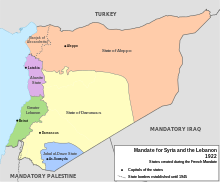Sanjak Alexandrette
The Sanjak Alexandrette ( Ottoman سنجاق اسکندرون, Turkish İskenderun Sancağı , French Sandjak d'Alexandrette ) was an administrative unit in the mandate of Syria and Lebanon , which existed from 1918 to 1938 and was administered by France .
history
The Sanjak of Alexandretta was on 27 November 1918 by the French military administration in during the First World War conquered territories of the Ottoman Empire created by the sub-district (Turk. Kaza , arab. Qaḍā' ) Alexandretta and the subdistrict Antioch of the Aleppo Vilayet the Sanjak of Alexandretta summarized were. The administrative seat was the eponymous city of Alexandrette ( İskenderun ).
On September 7, 1938, the state of Hatay was founded from the Sanjak Alexandrette , a transitional structure that lasted until June 29, 1939. Shortly before the start of the Second World War , this state of Hatay was ceded by France to Turkey on July 23, 1939 in order to induce Turkey to be neutral during the war. Head of State of Hatay (with the title Hatay Devleti Reisi ) was Tayfur Sökmen (1892–1980), while Abdurrahman Melek (1896–1978) served as Prime Minister. Both were in office from September 5, 1938 to July 23, 1939.
The area is now called Hatay and is a Turkish province .
population
The population of Sanjak Alexandrette was 219,000 in 1936 and, according to official French statistics, consisted of 38.9% Turks, 28% Alawite Arabs, 10% Sunni Arabs, 8.2% Christian Arabs and 11.4% Armenians . Turkey, however, claims that 80% of the region was already inhabited by Turks. According to some historians, the ethnic composition of Turkey was massively influenced by a policy of ethnic cleansing in 1938.
literature
- Yasar Demir: Le rattachement du Sandjak d'Alexandrette à la Turquie. L'ambition turque et l'influence des dynamiques locales sur le rattachement . Éditions universitaires européennes, Saarbrücken 2010, ISBN 978-3-8417-8060-7 .
Web link
Individual evidence
- ^ Art. Iskandarūn . In: Encyclopaedia of Islam , 2nd ed., Vol. 4: Iran – Kha . Brill, Leiden 1978, ISBN 90-04-05745-5 , p. 138.
- ↑ Dalal Arsuzi-Elamir: Arab Nationalism in Syria. Zakī al-Arsūzī and the Arab national movement on the periphery of Alexandretta / Antakaya 1930–1938. (= Studies on the Contemporary History of the Middle East and North Africa , Volume 9), Lit, Münster 2003, ISBN 3-8258-5917-7 , p. 25. According to other information, 30,000 Antiochene Greeks must also be taken into account. See Peter Alford Andrews: Ethnic Groups in the Republic of Turkey , Dr. Ludwig Reichert Verlag, Wiesbaden 1989, ISBN 3-89500-297-6
- ^ Robert Fisk: The Great War for Civilization. The Conquest of the Middle East . Vintage, New York 2007, ISBN 978-1-4000-7517-1 , p. 335.
- ↑ Jack Kalpakian: Identity, Conflict and Cooperation in International River Systems . Ashgate Publishing, Aldershot 2004, ISBN 0-7546-3338-1 , p. 130.

